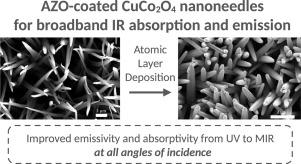AZO-coated refractory nanoneedles as ultra-black wide-angle solar absorbers
IF 6.3
2区 材料科学
Q2 ENERGY & FUELS
引用次数: 0
Abstract
Nanoneedles fabricated from refractory materials, such as copper cobaltate, are promising materials for solar energy conversion due to their favorable light-trapping properties at high temperatures. We demonstrate that coating these materials with a thin aluminum-doped zinc oxide (AZO) layer improves their optical properties dramatically, leading to a very low () reflectance in a wide spectral range, from the ultraviolet to the near-infrared ( m). This advantageous property is present even at very large angles of incidence (), which makes this material attractive for increasing the acceptance angle of central-receiver concentrating solar power systems or as an ultra-black diffuse optical component for infrared imaging systems. Finally, the exceptionally high emissivity of this material in the near- and mid-infrared at temperatures up to 600 °C proves that its optical properties are thermally resistant and suggests that the material can be used as a high-temperature alternative to ultra-black coatings made of vertically aligned carbon nanotubes.

偶氮涂层难熔纳米针作为超黑广角太阳能吸收剂
由难熔材料(如钴酸铜)制成的纳米针由于在高温下具有良好的光捕获特性,是一种很有前途的太阳能转换材料。我们证明,在这些材料上涂上一层薄的掺铝氧化锌(AZO)层可以显著改善它们的光学性能,从而在从紫外到近红外(0.3−2 μm)的宽光谱范围内实现极低(<1%)的反射率。即使在非常大的入射角(θ=70°)下,这种有利的特性也存在,这使得这种材料对于增加中央接收器聚光太阳能发电系统的接收角或作为红外成像系统的超黑漫射光学元件具有吸引力。最后,该材料在高达600°C的温度下,在近红外和中红外波段具有极高的发射率,这证明了它的光学性能是耐热的,并表明该材料可以用作由垂直排列的碳纳米管制成的超黑涂层的高温替代品。
本文章由计算机程序翻译,如有差异,请以英文原文为准。
求助全文
约1分钟内获得全文
求助全文
来源期刊

Solar Energy Materials and Solar Cells
工程技术-材料科学:综合
CiteScore
12.60
自引率
11.60%
发文量
513
审稿时长
47 days
期刊介绍:
Solar Energy Materials & Solar Cells is intended as a vehicle for the dissemination of research results on materials science and technology related to photovoltaic, photothermal and photoelectrochemical solar energy conversion. Materials science is taken in the broadest possible sense and encompasses physics, chemistry, optics, materials fabrication and analysis for all types of materials.
 求助内容:
求助内容: 应助结果提醒方式:
应助结果提醒方式:


